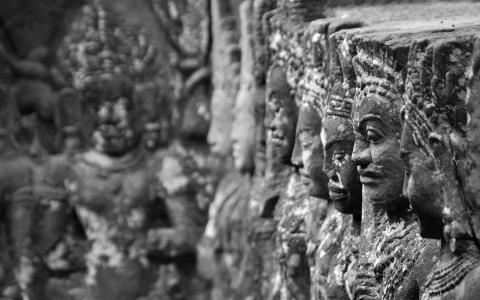
For a moment, just visualize the kind of public debates that happen today – on television, in the newspapers, and in person. In the light of these images floating in your mind, read the following lines:
Why fear them? Why pay attention?
Why listen to your opponent’s words?
Just contradict them immediately.
You are sure of victory in the debate!
The five rules for victory are:
be cool, be shameless, be mocking,
despise your opponent, and
praise...

This is a short glossary of some of the technical terms often seen in Hindu literature. A glossary such as this becomes inevitable on most occasions since many of these terms don't have single word equivalents in English or any non-Indic language, since these concepts are often not found in other cultures.
artha • wealth; motive; cause. It refers to the material objectives and accomplishments of a person. One of the four puruṣārthas.
ātman •...

The foundational works of Hinduism have, for centuries, been transmitted by means of an oral tradition – teachers taught their disciples, who committed every word to memory and then passed it on to their disciples without any variation. Needless to say, many ancient texts have been lost over the years. For ease of understanding, in this article we use the term ‘texts’ instead of ‘works,’ or ‘compositions,’ or ‘treatises,’ but they include both...

This is the second part of the article, Sanatana Dharma from Scratch by Shatavadhani Dr. R Ganesh, discussing about several fundamental aspects of Hinduism.
Rta, Rna, Dharma
True value realization takes us closer to the Vedic concept of ऋत (rta). The word rta has no equivalent in English but can loosely be translated as ‘cosmic order in the universe,’ ‘divine law governing the universe,’ or ‘gnostic order that is inherent in the universe.’ The...

In its original and purest form, Hinduism is a sanatana dharma, loosely translated as ‘eternal truth’ or ‘timeless religion’ or ‘eternal way of life’ or ‘timeless ethic.’ It is drawn from nature and thus unrestricted by space-time constraints. However, in the several applications of sanatana dharma, we adopt specific spatiotemporal frames.
The word सनातन—sanatana—symbolizes eternity. From linguistic and cultural viewpoints, the word sanatana is...

Hinduism is the major religion of India with a worldwide following of over a billion people. In its original and purest form, it is a sanatana dharma (loosely translated as ‘eternal truth’ or ‘timeless religion’) that represents at least 7,000 years of contemplation, tradition, and continuous development in India. One who follows Hinduism is called a ‘Hindu’ (the term originally referred to a person who lived beyond the Sindhu river, i.e. in...
